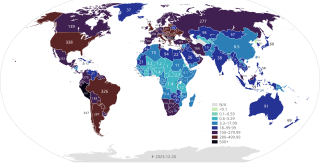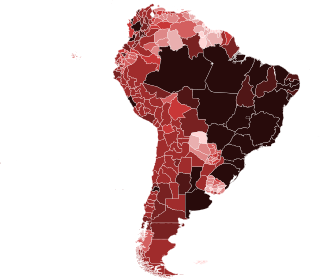Related Research Articles

This is a general overview and status of places affected by severe acute respiratory syndrome coronavirus 2 (SARS-CoV-2), the virus which causes coronavirus disease 2019 (COVID-19) and is responsible for the COVID-19 pandemic. The first human cases of COVID-19 were identified in Wuhan, the capital of the province of Hubei in China in December 2019. It spread to other areas of Asia, and then worldwide in early 2020.

The COVID-19 pandemic began in Asia in Wuhan, Hubei, China, and has spread widely through the continent. As of 3 July 2024, at least one case of COVID-19 had been reported in every country in Asia except Turkmenistan.

The first cases of the COVID-19 pandemic of coronavirus disease 2019 in North America were reported in the United States on 23 January 2020. Cases were reported in all North American countries after Saint Kitts and Nevis confirmed a case on 25 March, and in all North American territories after Bonaire confirmed a case on 16 April.
The COVID-19 pandemic in Norway has resulted in 1,508,485 confirmed cases of COVID-19 and 5,732 deaths.

The COVID-19 pandemic was confirmed to have spread to Africa on 14 February 2020, with the first confirmed case announced in Egypt. The first confirmed case in sub-Saharan Africa was announced in Nigeria at the end of February 2020. Within three months, the virus had spread throughout the continent, as Lesotho, the last African sovereign state to have remained free of the virus, reported a case on 13 May 2020. By 26 May, it appeared that most African countries were experiencing community transmission, although testing capacity was limited. Most of the identified imported cases arrived from Europe and the United States rather than from China where the virus originated.
The COVID-19 pandemic in Nigeria was a part of the worldwide pandemic of coronavirus disease 2019 caused by severe acute respiratory syndrome coronavirus 2. The first confirmed case in Nigeria was announced on 27 February 2020, when an Italian national in Lagos tested positive for the virus. On 9 March 2020, a second case of the virus was reported in Ewekoro, Ogun State, a Nigerian citizen who came into contact with the Italian national.
The COVID-19 pandemic in Qatar was a part of the worldwide pandemic of coronavirus disease 2019 caused by severe acute respiratory syndrome coronavirus 2. The virus was confirmed to have reached Qatar on 27 February 2020.

The COVID-19 pandemic was confirmed to have reached South America on 26 February 2020 when Brazil confirmed a case in São Paulo. By 3 April, all countries and territories in South America had recorded at least one case.
The COVID-19 pandemic in Kenya was a part of the worldwide pandemic of coronavirus disease 2019 caused by severe acute respiratory syndrome coronavirus 2. The virus was confirmed to have reached Kenya on 12 March 2020, with the initial cases reported in the capital city Nairobi and in the coastal area Mombasa.
The COVID-19 pandemic in Ethiopia was a part of the ongoing worldwide pandemic of coronavirus disease 2019 caused by severe acute respiratory syndrome coronavirus 2. The virus was confirmed to have reached Ethiopia on 13 March 2020. The national government, led by Prime Minister Abiy Ahmed, declared a five-month state of emergency in April 2020 but has allowed economic activities to continue during the public health crisis.
The ongoing COVID-19 pandemic was confirmed to have spread to Libya on 24 March 2020, when the first case was officially confirmed in Tripoli.
The COVID-19 pandemic was confirmed to have reached Somalia on 16 March 2020 when the first case was confirmed in Mogadishu. The Somali Prime Minister, Hassan Ali Khaire announced that the government has set aside five million dollars to deal with the disease. The Somali Medical Association is concerned that the death toll in the country will be huge and that Somalia will not be able to recover from the economic effects due to poor working relations between central government and federal states which leads to lack of control by central government, as well and the lack of healthcare infrastructure. It has also been speculated that President Mohamed Abdullahi Mohamed may use the pandemic as an excuse to postpone elections. There have also been concerns over freedom of the press following arrests and intimidation of journalists who have been covering the pandemic in Somalia.

The COVID-19 pandemic in Benin was a part of the ongoing worldwide pandemic of coronavirus disease 2019 caused by severe acute respiratory syndrome coronavirus 2. The virus was confirmed to have reached Benin in March 2020.
The COVID-19 pandemic in Equatorial Guinea was a part of the worldwide pandemic of coronavirus disease 2019 caused by severe acute respiratory syndrome coronavirus 2. The virus was confirmed to have reached Equatorial Guinea on 14 March 2020. Equatorial Guinea has a weak healthcare system, leaving it vulnerable to an outbreak.

The COVID-19 pandemic in Mozambique is part of the worldwide pandemic of coronavirus disease 2019 caused by severe acute respiratory syndrome coronavirus 2. The virus was confirmed to have reached Mozambique in March 2020.
The COVID-19 pandemic in South Sudan is part of the ongoing worldwide pandemic of coronavirus disease 2019 caused by severe acute respiratory syndrome coronavirus 2. The virus was confirmed to have reached South Sudan on 5 April 2020. The first four confirmed cases were all UN workers.
The COVID-19 pandemic in São Tomé and Príncipe is part of the worldwide pandemic of coronavirus disease 2019 caused by severe acute respiratory syndrome coronavirus 2. The virus was confirmed to have reached São Tomé and Príncipe on 6 April 2020. The first death was recorded on 30 April.
The first confirmed case relating to the COVID-19 pandemic in Yemen was announced on 10 April 2020 with an occurrence in Hadhramaut. Organizations called the news a "devastating blow" and a "nightmare scenario" given the country's already dire humanitarian situation.

The COVID-19 pandemic was confirmed in April 2020 to have reached Puntland, an autonomous state in northeastern Somalia.

The COVID-19 pandemic was confirmed to have spread to Africa on 14 February 2020, with the first confirmed case announced in Egypt. The first confirmed case in sub-Saharan Africa was announced in Nigeria at the end of February. Within three months, the virus had spread throughout the continent, as Lesotho, the last African sovereign state to have remained free of the virus, reported a case on 13 May. By 26 May, it appeared that most African countries were experiencing community transmission, although testing capacity was limited. Most of the identified imported cases arrived from Europe and the United States rather than from China where the virus originated. It is believed that there is widespread under-reporting in many African countries with less developed healthcare systems.
References
- ↑ "Ministry of Health Development Somaliland". Archived from the original on 30 December 2021. Retrieved 17 August 2021.
- 1 2 3 "UNPO: Coronavirus: Somaliland strives alone". unpo.org. Archived from the original on 6 April 2020. Retrieved 6 April 2020.
- ↑ "Somaliland Confirms 2 Covid-19 Cases". MENAFN. Archived from the original on 5 April 2020. Retrieved 31 March 2020.
- ↑ "Dawladda Somaliland oo Shaacisay laba qof oo laga helay Cudurka Covid-19". Wargeyska Dawan (in Somali). Archived from the original on 5 April 2020. Retrieved 31 March 2020.
- ↑ "COVID-19: Somaliland releases 574 prisoners". AA. 1 April 2020. Archived from the original on 6 April 2020. Retrieved 3 April 2020.
- ↑ "Somalia: COVID-19 impact update 2" (PDF). OCHA. 20 April 2020. p. 1. Archived (PDF) from the original on 9 January 2021. Retrieved 23 January 2021.
- ↑ "Somalia: COVID-19 impact update 3" (PDF). OCHA. 26 April 2020. p. 1. Archived (PDF) from the original on 30 January 2021. Retrieved 23 January 2021.
- ↑ "Somalia: COVID-19 impact update 6" (PDF). OCHA. 18 May 2020. p. 2. Archived (PDF) from the original on 22 May 2021. Retrieved 23 January 2021.
- ↑ "Somalia: COVID-19 impact update 7" (PDF). OCHA. 28 May 2020. p. 1. Archived (PDF) from the original on 29 January 2021. Retrieved 23 January 2021.
- ↑ "Somalia: COVID-19 impact update 12" (PDF). OCHA. 21 September 2020. p. 1. Archived (PDF) from the original on 10 October 2020. Retrieved 23 January 2021.
- ↑ "Somalia: COVID-19 impact update 13" (PDF). OCHA. 25 October 2020. p. 1. Archived (PDF) from the original on 22 January 2021. Retrieved 23 January 2021.
- ↑ Habib, Jacky (22 December 2020). "Meet the doctor coordinating Somaliland's COVID-19 response". Global Citizen. Archived from the original on 22 April 2021. Retrieved 23 January 2021.
- ↑ Dhaysane, Mohammed (9 February 2021). "Is Somalia ignoring coronavirus pandemic?". Anadolu Agency. Archived from the original on 10 March 2021. Retrieved 24 March 2021.
- ↑ "Somalia contemplates lockdown as COVID-19 pandemic wreaks havoc". Garowe Online. 1 March 2021. Archived from the original on 26 May 2021. Retrieved 26 May 2021.
- ↑ "Somaliland: Country Goes on High Covid-19 Alert, Establishes Stringent Virus Preventive..." menafn.com. Archived from the original on 5 April 2020. Retrieved 20 March 2020.
- ↑ "Somaliland and COVID-19: Emerging Issues and Economic Impact". 23 April 2020. Archived from the original on 23 June 2021. Retrieved 6 October 2020.
- ↑ "Somaliland: Why We Still Allow Flights by Ethiopian Airlines and Continued Khat..." menafn.com. Archived from the original on 6 April 2020. Retrieved 6 April 2020.
- ↑ "Overview of COVID-19 directives, 30 May 2020". ReliefWeb. 1 June 2020. Retrieved 2 July 2024.
- ↑ "Overview of COVID-19 directives, 30 May 2020". ReliefWeb. 1 June 2020. Archived from the original on 16 November 2022. Retrieved 13 June 2024.
- ↑ "COVID-19: Somaliland releases 574 prisoners". www.aa.com.tr. Archived from the original on 6 April 2020. Retrieved 6 April 2020.
- ↑ "Taiwan's donation of Medigen COVID-19 vaccines arrives in Somaliland". Archived from the original on 31 January 2022. Retrieved 31 January 2022.
- ↑ "How Taiwan and Somaliland are managing COVID19 without international aid". East African Business Week. 28 April 2020. Archived from the original on 24 September 2020. Retrieved 15 May 2020.